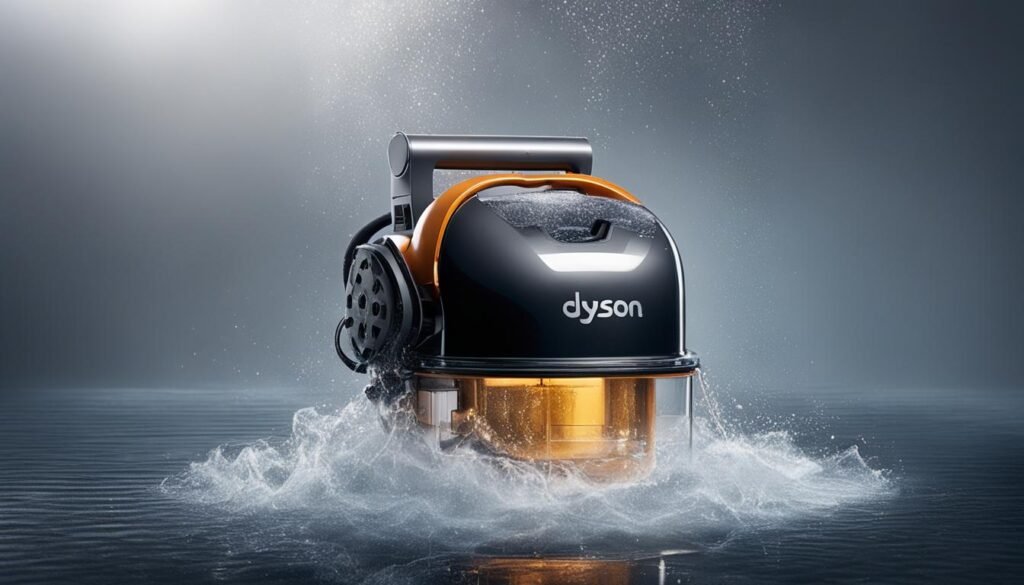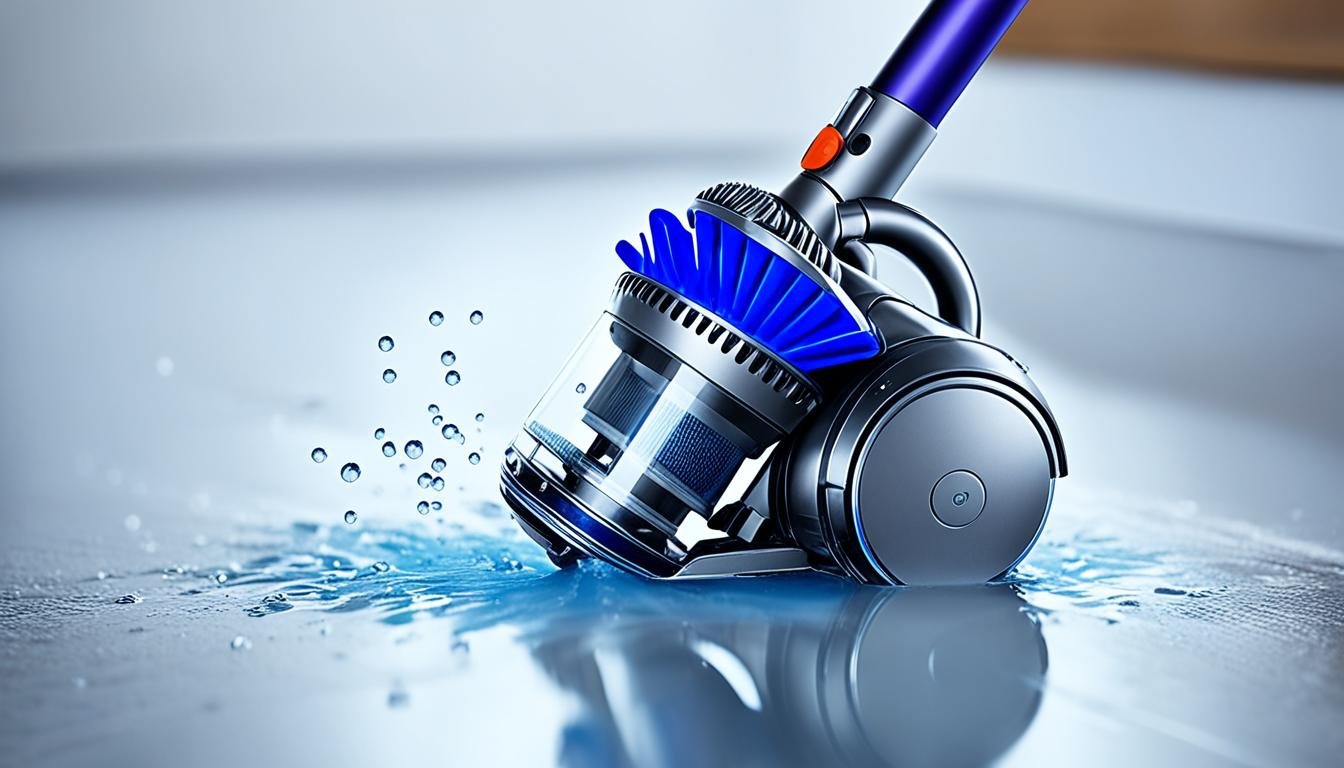Oops! I recently found myself in a bit of a predicament when I accidentally vacuumed up some water with my trusty Dyson. If you’re facing a similar situation, don’t panic! I’ve got you covered with some helpful tips on what to do and how to prevent any potential damage to your beloved vacuum cleaner.
The first thing you should do if you’ve accidentally vacuumed water with your Dyson is to switch off the vacuum immediately. This will help prevent any electrical issues and further damage. Then, take a deep breath and proceed with the following steps:
- Disassemble and Dry: Take apart all the parts of your Dyson, such as the dustbin, filters, and dust bags. Give them a thorough cleaning and allow them to dry completely. It’s crucial to replace the vacuum cleaner bag and any non-washable filters to ensure optimal performance.
- Patience is Key: It’s important to wait until everything is completely dry before using your Dyson again. Rushing to use the vacuum cleaner while any moisture remains can lead to further damage and costly repairs.
- Prevention is Better Than Cure: To prevent water damage in the future, avoid vacuuming in areas with water spills, such as the bathroom and kitchen. Be cautious around pet waterers and recently-mopped floors to minimize the risk of water entering your Dyson.
Key Takeaways:
- Switch off the vacuum immediately to avoid electrical issues after accidentally vacuuming water with your Dyson.
- Disassemble and thoroughly dry all the parts, replacing the vacuum cleaner bag and any non-washable filters.
- Wait until everything is completely dry before using your Dyson to avoid further damage.
- Prevent future water damage by avoiding vacuuming in areas with water spills and being cautious around pet waterers and recently-mopped floors.
With these steps in mind, you can handle a water mishap with your Dyson like a pro and keep your vacuum cleaner in top-notch condition. Happy vacuuming!
What Happens When Water Gets into a Vacuum Cleaner?
When water enters a vacuum cleaner, it can cause various issues, depending on the amount of water involved. Small amounts of water may not immediately damage the vacuum cleaner, but it can lead to unpleasant odors or clogging of the vacuum cleaner hose. If the water reaches the motor, it can result in motor damage and potential malfunctioning of the vacuum cleaner.
Water in the hose or any leaks in the vacuum cleaner can also compromise its effectiveness in suctioning dirt and debris. It is essential to stop using the vacuum cleaner immediately after water enters it to prevent further damage.
To illustrate the potential effects of water entering a vacuum cleaner, let’s take a look at the following table:
| Effects of Water in a Vacuum Cleaner | Potential Damage |
|---|---|
| Unpleasant Odors | ✓ |
| Clogging of Vacuum Cleaner Hose | ✓ |
| Motor Damage | ✓ |
| Malfunctioning of the Vacuum Cleaner | ✓ |
| Compromised Suction Power | ✓ |

The table above clearly demonstrates the potential damage caused by water in a vacuum cleaner. From unpleasant odors to compromising suction power, it’s important to address any water-related issues promptly to prevent further harm to your Dyson vacuum cleaner.
By being aware of the potential consequences, you can take the necessary steps to prevent water from entering your vacuum cleaner and maintain its optimal performance. In the next section, we will explore how to fix a water-damaged Dyson vacuum cleaner and provide tips to handle such situations effectively.
How to Fix a Water-Damaged Dyson Vacuum Cleaner
If you accidentally vacuumed water with your Dyson vacuum cleaner, don’t panic. There are steps you can take to fix the damage and get your vacuum back in working condition.
The first thing you should do is switch off the vacuum cleaner immediately to prevent any electrical issues. Then, disconnect and remove all the components, such as the dustbin, filters, and dust bags. Empty and dry the dustbin thoroughly, ensuring there is no remaining moisture.
Next, clean or replace the filters, depending on their washability. Not all vacuum cleaner filters are washable, so make sure to check the manual and replace any non-washable filters. Allow all the parts of the vacuum cleaner to dry completely for at least two days before reassembling them.
If the motor of your Dyson vacuum cleaner has been exposed to water, it is crucial to seek professional assistance or consider replacing it. Water damage to the motor can lead to potential malfunctioning of the vacuum cleaner, and it’s best to follow the manufacturer’s guidelines for repair or replacement.
Remember to consult your Dyson vacuum cleaner’s manual for specific care and maintenance instructions. Taking proper care of your vacuum cleaner will help prevent future water damage and ensure its longevity.
FAQ
What should I do if I accidentally vacuumed water with my Dyson?
If you accidentally vacuumed water with your Dyson, switch off the vacuum immediately to avoid any electrical issues. Disassemble all the parts and allow them to dry thoroughly. Replace the vacuum cleaner bag and any non-washable filters. Wait until everything is completely dry before using the vacuum cleaner again to prevent further damage.
What happens when water gets into a vacuum cleaner?
When water enters a vacuum cleaner, it can cause various issues. Small amounts of water may lead to unpleasant odors or clogging of the vacuum cleaner hose. If the water reaches the motor, it can result in motor damage and potential malfunctioning of the vacuum cleaner. Water in the hose or any leaks can also compromise its effectiveness in suctioning dirt and debris.
How can I fix a water-damaged Dyson vacuum cleaner?
To fix a water-damaged Dyson vacuum cleaner, switch off the vacuum cleaner and remove all the components, such as the dustbin, filters, and dust bags. Empty and dry the dustbin and clean or replace the filters. Let all the parts of the vacuum cleaner dry thoroughly for at least two days before reassembling them. If the motor of the vacuum cleaner has been exposed to water, it may require professional assistance or replacement.
Can a Dyson vacuum cleaner handle water?
Dyson vacuum cleaners are not designed to handle water. If water enters a Dyson vacuum cleaner, it can cause damage to the motor and other components. It’s important to avoid vacuuming in areas with water spills and to be cautious around pet waterers and recently-mopped floors to prevent water damage.
How can I prevent water damage to my Dyson vacuum cleaner?
To prevent water damage to your Dyson vacuum cleaner, avoid vacuuming in areas with water spills, such as the bathroom and kitchen. Be cautious around pet waterers and recently-mopped floors. If any water spills occur near the vacuum cleaner, make sure to clean them up promptly and ensure the vacuum cleaner remains dry.





Leave a Reply